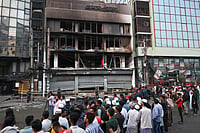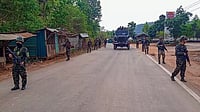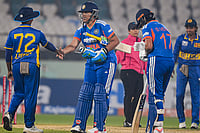DURING the fierce communal clashes of the late 20s and 30s after thecollapse of the Khilafat movement, even Gandhiji lost heart and is reported to have said:"Only God can solve the Hindu-Muslim problem." Sudhir Kakar is not God but heenjoys a semi-divine status among the Indian intelligentsia, having made psychoanalyticalforays into the world of Shaman mystics and Indian cinema.
Colours, about the Hindu-Muslim conflict, is a major achievement on a par with Talesof Love, Sex and Danger for its originality and far above his other books infield-work and research.
And yet the "Hindu-Muslim problem" is a notorious trap and Kakar has notescaped unscathed.
He confesses his aims are modest: to concentrate on a "psychoanalystsexploration of the problem so as to deepen the understanding provided by otherdescriptives". The concern is with the concept of group identity and allthe ramifications and the complexity the term implies. The main case study concerns theHindu-Muslim violence in Hyderabad, 1990. Kakar travels back and forth in history. Hediscusses the issue from the point of view of past history, with presentwarriors and victims. The emphasis is on personal experientialinvestigation.
Kakars method does open up vistas not hitherto noticed. Yet there are limitations(already admitted) here which must be kept in mind, lest the work is considered adefinitive one on the issue.
Kakars chapters on "past" Hyderabad are not very satisfactory. Heshifts from Hyderabad history to general history with regard to the Hindu-Muslim conflict.Tavernier, Dubois etc are brought into the story particularly good old Dubois,inevitable in such studies, with his differentiation between internal Hindu squabbles andthe Hindus diff e rent kind of hate for Muslims. I think this view is a limitation.
The Hyderabad Hindu-Muslim problem is sui generis. There was inherent"communalism" in the Nizams rule (very different from the Hyder Ali-Tipurule in Mysore). A variant of that communalism arose after our police action in 1948. Thatbegan a reverse kind of "communalism", certainly not as bad as the Nizamsbut more effective because of its "secular" character.
Kakar makes the old unexamined distinction between "secularists" and"fundamentalists" among Hindus and Muslims. This is an over-simplificationtoday. After the Bombay riots of 1992-93 (and even before), most urban Hindus and Muslimsare both fundamentalist and secular.
The basic point is that while Kakar examines communalism at the "cuttingedge" at the level of actual fighters and victims excellently, hisself-imposed exclusion of large political social forces serves him badly. When I worked asa tax official in Hyderabad in the 60s, I found the atmosphere subtly buteffectively communal from the highest to the lowest class. An order I passed in favour ofa Muslim was fiercely fought up to the Supreme Court. In the high court an advocatepointed to the fact that I was a Muslim and so was the taxpayer. Talk of Johnny Cochran.The fact that the Supreme Court upheld my order is irrelevant to the issue.
The strength of the book lies in its psy-choanalytical analysis of the"warriors" and the "victims" at the "lowest" level. Certainly this is important and has never been done with this degree of objectivity,professional thoroughness and a sense of humour. The analysis of the akhara cultureboth Hindu and Muslim is masterly both in its historical concept and on aperson-to-person level. The same applies to the investigation of the"victims" both Hindu and Muslim in respective "minority"areas. The link between self-images and self-seeking during riots is perfectly traced. Onewished for a more elaborate linking of this situation with exploitation by politicalparties but thats not on Kakars agenda.
One more area should have been paid some attention. There s a difference betweenHindu and Muslim revivalisms. The Hindu "revivalism" is BJP-inspired and isalready passing. The Muslim revivalism is different. Its a worldwidephenomenon positive in Chechnya and Bosnia, negative in Iran and Algeria. Itsbased on a historical trend among Muslims. When Ali Sardar Jaff rey in a magnificent poemlaments the anti-Muslim genocide of Bombay, his whole frame of reference is to far awayand long ago Karbala.
I really did not expect Kakar to explore that aspect. But he has written a magnificentbook which certainly deepens our understanding.


























